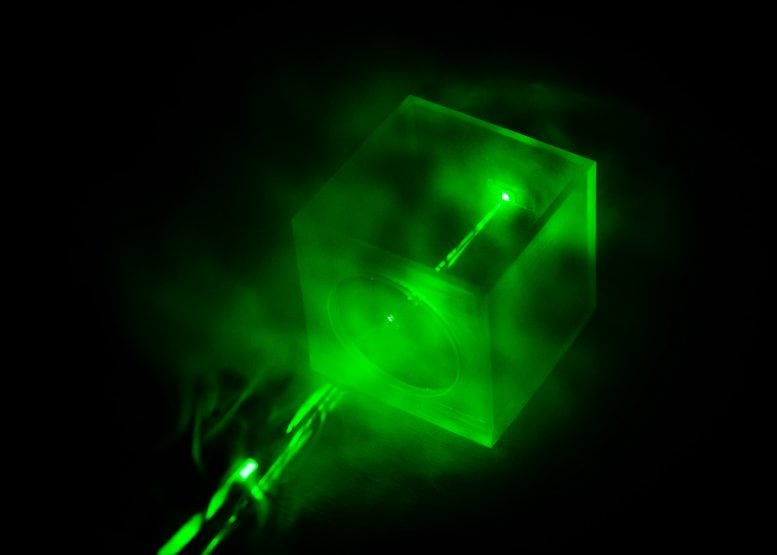
A Raman laser shining on the special chip, which traps gases and amplifies the laser signals, allowing for rapid analysis. Credit: NTU Singapore
Scientists at Nanyang Technological University, Singapore (NTU Singapore) have developed a device that can identify a wide range of airborne gases and chemicals instantly.
The new prototype device is portable and suitable for rapid deployment by agencies to identify airborne hazards, such as from tiny gas molecules like sulfur dioxide. It can also identify larger compound molecules such as benzene, known to be harmful to human health.
It can provide real-time monitoring of air quality such as during haze outbreaks, and assist in the detection of gas leaks and industrial air pollution.
Developed by a research team led by Associate Professor Ling Xing Yi at the School of Physical and Mathematical Sciences, the new technology was reported last month in the science journal ACS Nano.
Current methods of identifying gases in the air use a laboratory technique called Gas Chromatography — Mass Spectrometry (GC-MS), which is reliable but requires tedious sample collection and takes between a few hours and a few days to obtain results from air samples.
Emergency scenarios require a fast and ongoing analysis of potential air contamination, such as following a natural disaster, chemical spill, or illegal dumping of toxic waste, so that emergency responders can take appropriate action.
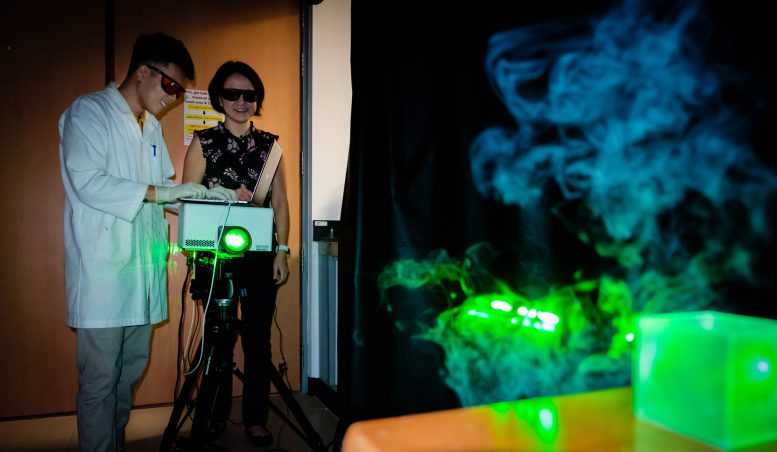
Assoc Prof Ling Xing Yi (right) with Ph.D. student Phan Quang Gia Chuong (left) operating the gas analyzer laser device that can detect gases and airborne chemicals instantly. Credit: NTU Singapore
How the new device works
The new device uses a small patch made of a special porous and metallic nanomaterial to first trap gas molecules. When a laser is shone on it from a few meters away, the light interacts with the gas molecules, causing the light of lower energy to be emitted. When analyzed, it gives a spectroscopic readout in the format of a graph chart.
The spectroscopic readout acts like a “chemical fingerprint” corresponding to various chemicals present on the patch. The whole process takes about 10 seconds to complete.
These chemical fingerprints from the sample are referenced against a digital library of fingerprints to quickly determine what chemicals have been detected.
Known as Raman spectroscopy, this is a long-established technique for identifying chemical substances. Typically, it has been used only on solid and liquid samples, since gaseous chemicals are too dilute for the laser and detector to pick up.
To overcome this limitation, Assoc Prof Ling and her Ph.D. student Mr. Phan Quang Gia Chuong developed a special nanostructure made from a highly porous synthetic material known as a metal-organic framework, which actively absorbs and traps molecules from the air into a ‘cage’.
This nanostructure also contains metal nanoparticles, which boost the intensity of the light surrounding the molecules. The result is a million-fold enhancement in the Raman spectroscopy signals, which allows for the identification of the trapped molecules.
Assoc Prof Ling said the genesis of the invention was sparked by an incident in Singapore, where there were reports of a strong gas-like odor over certain parts of the island in 2017. The cause was only determined a few days later, and was traced to volatile organic compounds released by factories outside of Singapore.
Together with her husband, Dr. Phang In-Yee, a project leader and scientist at the Institute of Materials Research and Engineering (IMRE), they conceptualized the idea of identifying gases instantly from a distance.
“Our device can work remotely, so the operation of the laser camera and analysis of chemicals can be done safely at a distance. This is especially useful when it is not known if the gases are hazardous to human health,” explains Assoc Prof Ling, Head of the Division of Chemistry & Biological Chemistry at NTU.
The laser was tested in experiments to work up to 10 meters (33 feet) away and can be engineered to reach further distances. Another possible method is to use the chip to capture gases, which are subsequently analyzed with a laser.
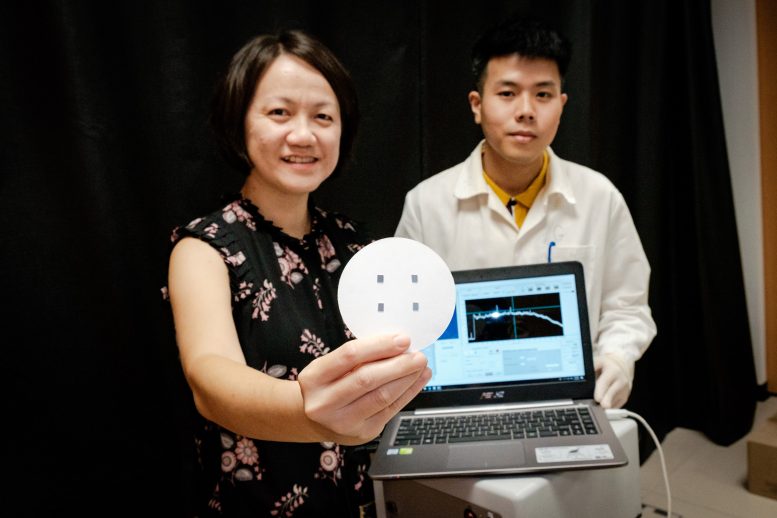
NTU Assoc Prof Ling Xing Yi (left) and Ph.D. student Phan Quang Gia Chuong, holding their specially designed chip that can trap gas molecules. Credit: NTU Singapore
Ultra-sensitive and accurate result
In experiments, the team showed that the device can identify airborne molecules such as polyaromatic hydrocarbons (PAH), including naphthalene and derivatives of benzene, a family of colorless industrial air pollutants known to be highly carcinogenic.
It can detect PAHs at parts-per-billion (ppb) concentrations in the atmosphere as well as perform continuous monitoring of the concentration of the different types of gases like carbon dioxide (CO2) in the atmosphere, which could be a useful application in many industrial settings.
The laser used in the device has an energy intensity of 50 milliwatts, more than seven times weaker than in other applications of Raman spectroscopy. This makes the system safer to operate and more energy efficient.
Through NTUitive, NTU’s innovation and enterprise company, the team has filed for a patent and is now commercializing the technology for use in pollution monitoring, chemical disaster response, as well as other industrial applications.
Reference: “Tracking Airborne Molecules from Afar: Three-Dimensional Metal–Organic Framework-Surface-Enhanced Raman Scattering Platform for Stand-Off and Real-Time Atmospheric Monitoring” by Gia Chuong Phan-Quang, Ningchen Yang, Hiang Kwee Lee, Howard Yi Fan Sim, Charlynn Sher Lin Koh, Ya-Chuan Kao, Zhao Cai Wong, Eddie Khay Ming Tan, Yue-E Miao, Wei Fan, Tianxi Liu, In Yee Phang and Xing Yi Ling, 13 September 2019, ACS Nano.
DOI: 10.1021/acsnano.9b06486

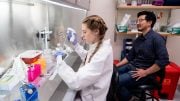
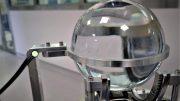
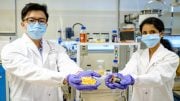

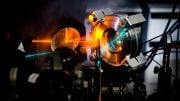
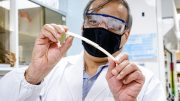
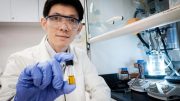
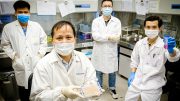
Someone PLEASE take this invention and vocus it on all types of jet engine airplanes and all kinds of rockets and bombs . You will see proof that they are all polluting the planet and causing massive global warming. Jet engine airplanes are gigantic vacuum machines sucking up valuable moisture molecules in the upper atmosphere where clouds form and lessening the concentration in our atmosphere of moisture molecules which decreases clouds which causes less rain and allows more of the sun’s hot heat waves to reach the Earth thus increasing global warming. Clouds are the Earth’s umbrella which helps stop the sun’s rays from heating up the Earth. Without clouds the Earth will turn into a planet like Mars or Venus. Without clouds there would be no rain. Global warming deniers need to see this data to convince them that global warming is real and what things are causing it! Check out my Facebook page, Ron McCune from Chicago Illinois to see more about how to end global warming easily, especially if we use this invention to do so. I have 2 Facebook pages under my name and same town.
I would like to see this used to detect gunshot residue or gun oil. It would be a helpful tool in policing, especially in Chicago. Or use in flatuence to detect cancer. Need more ideas, let me know.